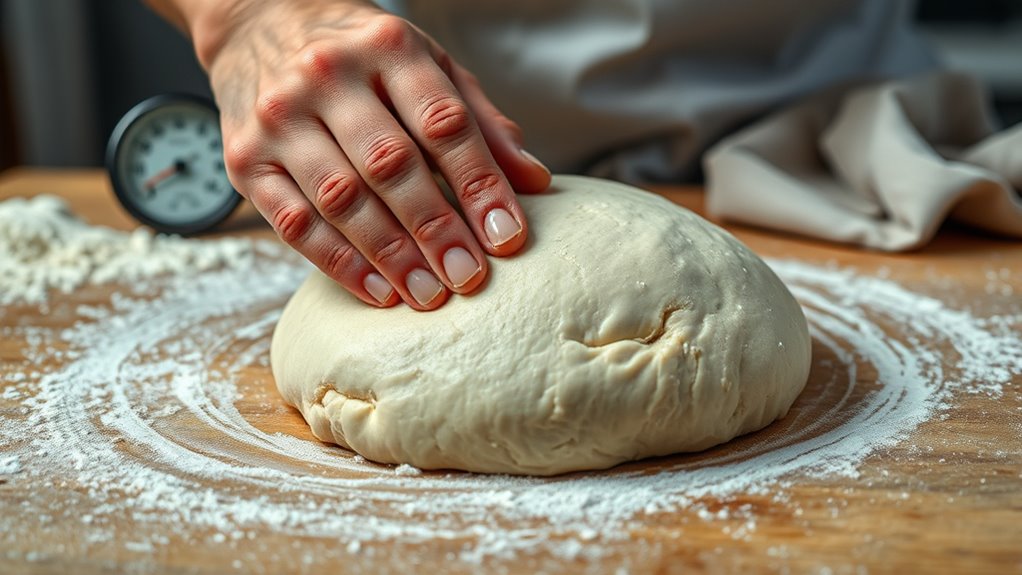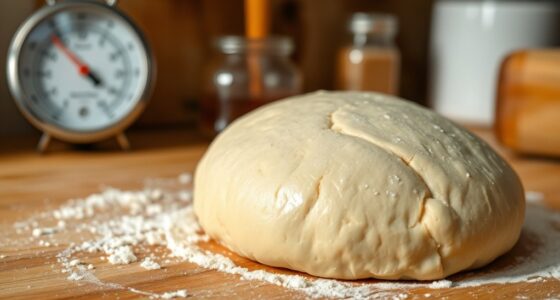Humidity substantially affects your dough’s texture and rise. High humidity makes the dough sticky and hard to work with, while low humidity dries it out, making it tough to shape. To troubleshoot, adjust your flour and water ratios, keep dough covered, and use tools like humidifiers or dehumidifiers. Monitoring moisture levels helps you maintain consistent results. Stay attentive to these tips, and you’ll gain the skills to manage dough perfectly in any environment.
Key Takeaways
- High humidity causes sticky dough, while low humidity results in stiff, dry dough; adjust hydration accordingly.
- Use humidity sensors and climate control tools like humidifiers or dehumidifiers to maintain optimal environment.
- Cover dough properly with plastic wrap or damp towels to prevent moisture loss or excess absorption.
- Adjust flour and liquid ratios based on environmental humidity to achieve desired dough consistency.
- Modify fermentation times and techniques to accommodate humidity fluctuations for consistent baking results.
Understanding How Humidity Affects Dough Composition
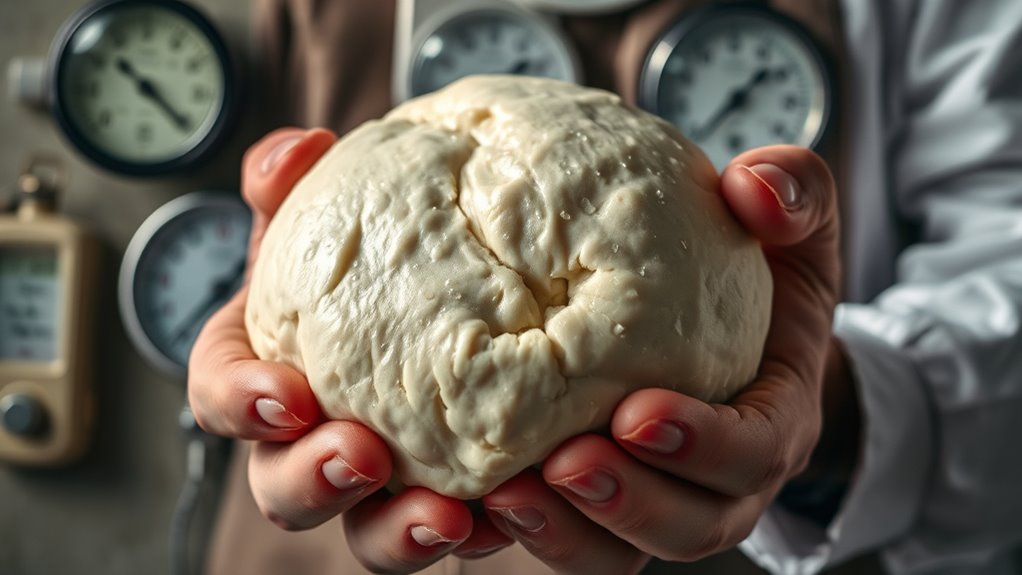
Humidity directly impacts dough composition by influencing the moisture content of the ingredients. When humidity levels are high, your dough absorbs more moisture from the air, making it softer and more pliable. Conversely, low humidity causes the dough to lose moisture, resulting in a stiffer, drier texture. These fluctuations affect dough elasticity, which is vital for shaping and rising properly. High humidity can lead to overly sticky dough that’s hard to work with, while low humidity can produce a tough, crumbly consistency. Understanding how humidity impacts moisture levels helps you adjust ingredient ratios or kneading times accordingly. By monitoring humidity levels, you can better control your dough’s elasticity, ensuring consistent results regardless of environmental conditions. Additionally, being aware of necessary cookies can help you understand how the website tracks and manages your preferences for optimal browsing.
Recognizing Signs of Humidity-Related Dough Issues
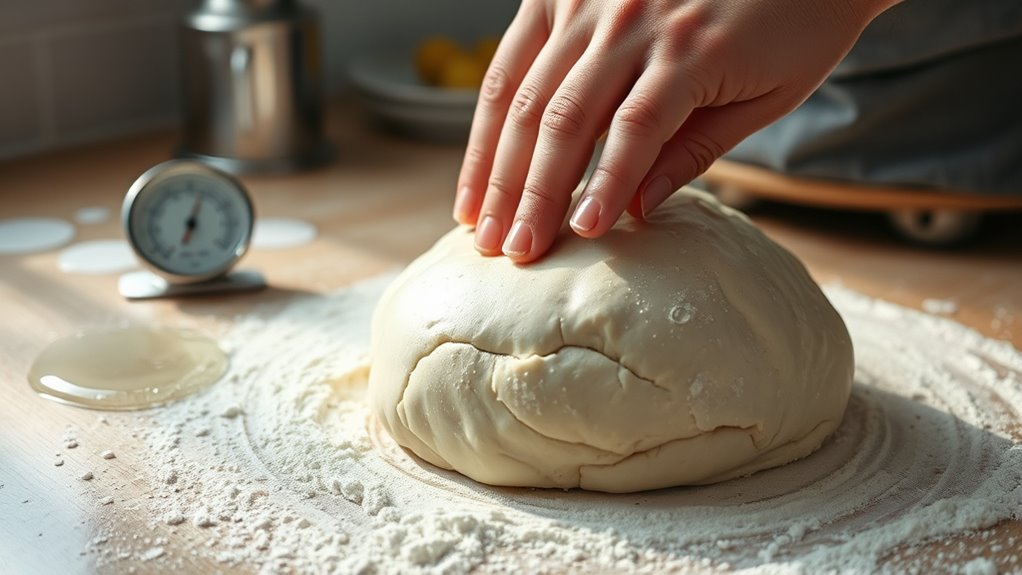
When your dough behaves unexpectedly during mixing or shaping, it often signals humidity-related issues. You might notice that dough fermentation seems sluggish or overly rapid, indicating altered yeast activity due to moisture levels. If the dough feels excessively sticky or slack, humidity may be causing the flour to absorb more water than usual, impacting its structure. Conversely, if it becomes too stiff or resistant, low humidity could have dried out the surface, hindering proper fermentation. Pay attention to how the dough responds—dough fermentation may slow down or speed up unexpectedly. These signs suggest humidity is affecting dough behavior, impacting yeast activity and overall rise. Recognizing these cues helps you diagnose humidity problems early and prepare to adjust your process accordingly. Additionally, understanding humidity’s effect on ingredients can help you better control your baking environment for consistent results.
Adjusting Flour and Liquid Ratios for Humidity Variations
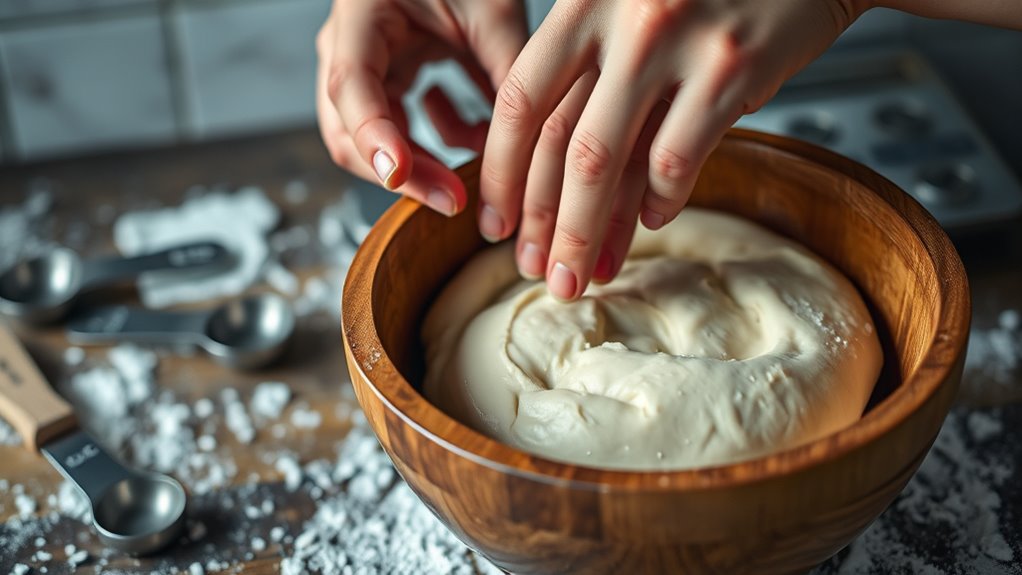
When humidity changes, the flour’s absorption rate shifts, affecting your dough’s consistency. You may need to tweak the amount of liquid you add to achieve the right texture. Understanding how different flours absorb liquids helps you make precise adjustments for consistent results. Using durable materials can also help maintain the proper dough consistency during varying environmental conditions.
Flours’ Absorption Capacity
Flours vary in their ability to absorb liquids, and this capacity can change with humidity levels. Different flour types, such as bread flour, pastry flour, or whole wheat, have distinct moisture content and absorption rates. When humidity is high, flour tends to absorb more moisture from the air, which can make your dough feel stiffer or drier if you use the same amount of liquid. Conversely, in dry conditions, you might need to add more liquid to achieve the right consistency. Understanding your flour’s absorption capacity helps you adjust your recipes accurately. Moisture content also impacts the dough’s elasticity, making it essential to monitor and modify your liquid ratios accordingly. Keep in mind that moisture content varies among flour types, so you may need to experiment to find the perfect ratio under different humidity conditions. This ensures consistent dough behavior regardless of environmental changes.
Liquid Adjustments Strategies
Adjusting flour and liquid ratios is essential for maintaining dough consistency across different humidity levels. When humidity is high, your dough may become too sticky due to increased hydration levels, so you should reduce the liquid measurement slightly. Conversely, in low humidity, your dough can become dry and crumbly, requiring a bit more liquid. Always start with a standard recipe and make incremental adjustments based on how the dough feels. Use your senses—if it’s too wet or sticky, add a small amount of flour; if it’s too dry, add a little water. Keep track of these adjustments to refine your liquid measurement over time, ensuring your dough maintains the right hydration level regardless of external conditions. Incorporating vertical storage solutions can also help keep your baking supplies organized and accessible, making adjustments easier to implement.
Managing Dough Consistency in High-Humidity Environments
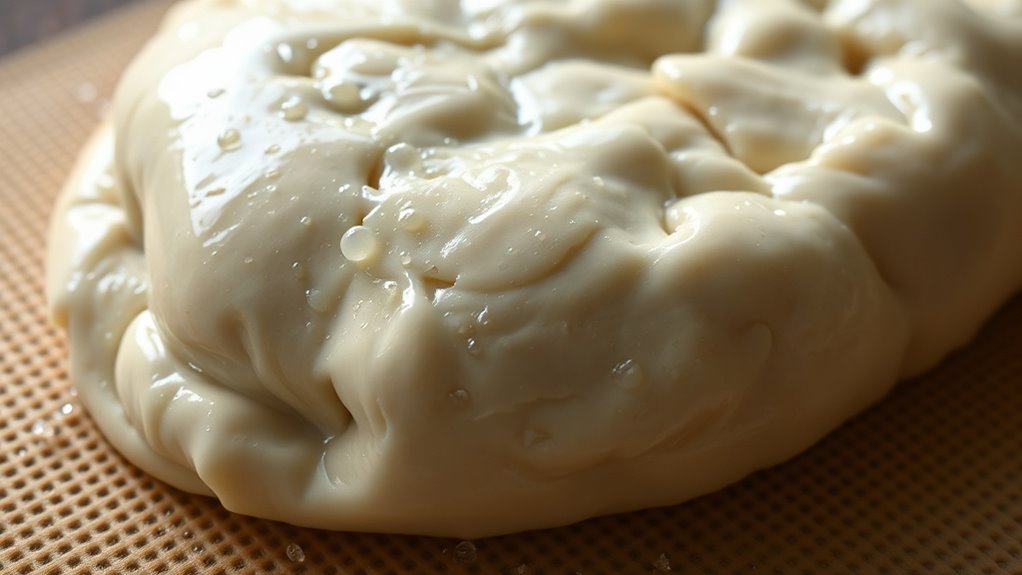
When humidity levels rise, your dough can become too sticky or soft, making it hard to handle. To maintain the right consistency, you should adjust the amount of flour you add and store your ingredients properly. These steps help you keep control over your dough despite the high-humidity environment. Utilizing proper food storage techniques can also prevent excess moisture from affecting your ingredients.
Adjust Flour Quantities
To maintain the right dough consistency in high-humidity environments, you need to carefully modify the amount of flour you use. Since excess humidity increases dough hydration, adding too much flour can balance the moisture and prevent overly sticky dough. Adjust your flour gradually, monitoring how it affects the dough’s texture. Use this table as a guide:
| Humidity Level | Flour Adjustment | Effect |
|---|---|---|
| Low | Slightly increase | Improves dough strength |
| Moderate | Maintain | Balanced dough hydration |
| High | Slightly decrease | Prevents stickiness |
| Very High | Decrease further | Maintains proper consistency |
| Extreme | Use less flour | Avoid overly sticky dough |
Controlling humidity and adjusting flour accordingly helps you achieve optimal dough behavior in varying conditions. Additionally, understanding dough behavior can further aid in troubleshooting issues caused by environmental factors.
Use Proper Storage
Proper storage plays a vital role in maintaining dough consistency, especially in high-humidity environments. To achieve effective humidity control, use airtight storage containers to keep moisture levels steady. These containers help prevent excess humidity from making your dough sticky or overly wet. Store your dough in a cool, dry place and avoid areas prone to temperature fluctuations. If you’re working in a particularly humid setting, consider adding a small amount of flour or dusting your dough lightly before storing to help absorb excess moisture. Always cover the dough tightly, either with a lid or plastic wrap, to prevent moisture from escaping or entering. Proper storage not only maintains the right dough texture but also reduces the risk of spoilage caused by excess humidity. Paying attention to kitchen environment, such as humidity levels, can further help in maintaining ideal dough consistency.
Techniques for Drying Out Dough in Low-Humidity Conditions

In low-humidity conditions, dough tends to lose moisture quickly, making it essential to employ specific techniques to prevent it from drying out completely. Using humidity sensors helps you monitor moisture levels accurately, so you can adjust your environment accordingly. Implement climate control measures, such as running a humidifier or placing a damp cloth nearby, to maintain consistent humidity around your dough. When working in a dry space, keep the dough covered with plastic wrap or a damp towel to slow moisture loss. Regularly check humidity levels with sensors to avoid over-drying. These precautions help maintain the dough’s elasticity and workability, ensuring it remains ideal for baking. Proper climate control and monitoring are your best tools for managing moisture in low-humidity environments. Additionally, utilizing headphones with Bluetooth can be helpful for listening to instructional videos or music while working on your baking projects without the hassle of wires.
Best Practices for Covering and Storing Dough to Control Moisture
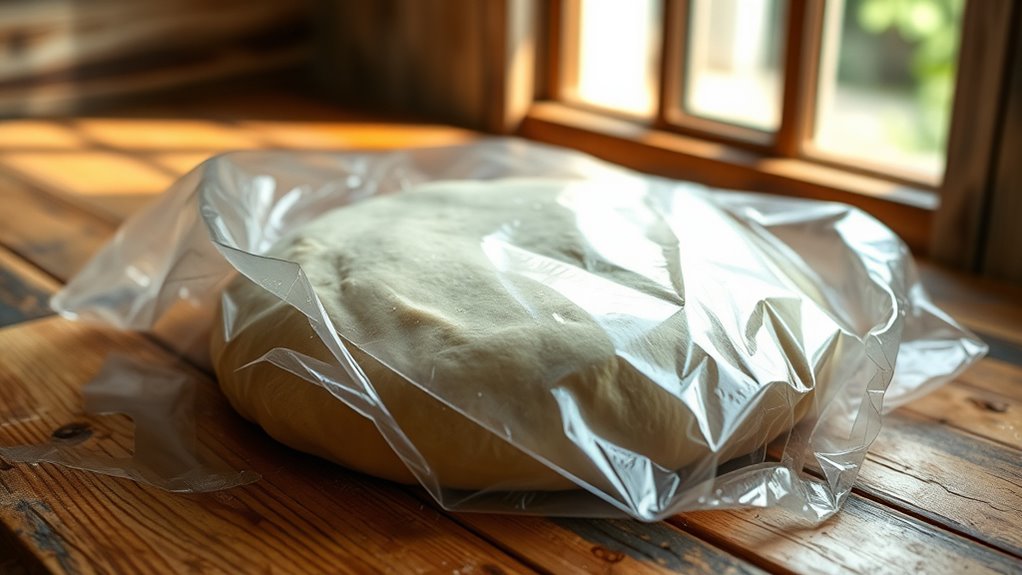
When storing dough, covering it correctly is essential for maintaining ideal moisture levels. An effective cover prevents dehydration, which can hinder dough fermentation and slow yeast activity. Use a damp cloth or plastic wrap, ensuring the cover is snug but not airtight, to retain moisture without suffocating the dough. Avoid tight seals that trap excess moisture, which can lead to overhydration and affect fermentation. If your environment is dry, lightly mist the cover to keep humidity consistent. Proper covering supports steady yeast activity, leading to better dough rise and texture. Store dough in a warm, draft-free area, and check periodically to ensure it stays moist. Consistent moisture levels promote favorable dough fermentation and successful baking results. Additionally, understanding how AI security measures monitor and adapt to environmental variables can help optimize storage conditions for best results.
Using Humidity-Absorbing and Humidity-Enhancing Tools
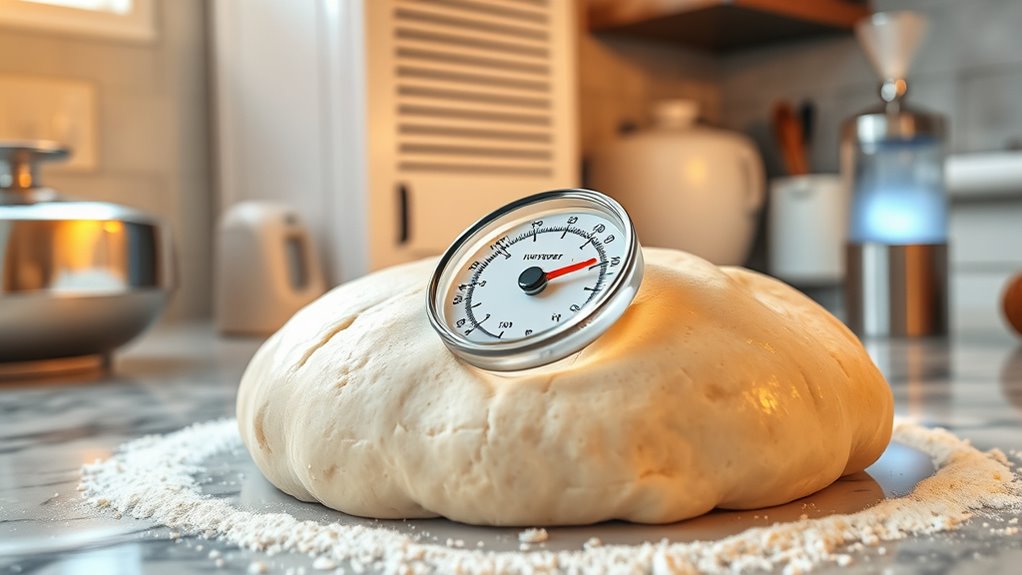
To effectively manage humidity levels in your baking environment, you can utilize tools designed to absorb excess moisture or add humidity as needed. Humidity monitoring devices help you keep track of moisture levels, ensuring precise control. For absorbing excess moisture, silica gel packs or dehumidifiers are effective, especially in humid conditions. Conversely, humidifiers or damp towels can raise humidity when it’s too dry. Regular tool calibration is essential; ensure your humidity monitors stay accurate by following manufacturer instructions. Proper calibration allows you to make informed adjustments, preventing over- or under-humidification. By using these tools thoughtfully, you maintain a consistent environment, which helps your dough behave predictably and improves your overall baking results.
Troubleshooting Common Dough Problems Caused by Humidity
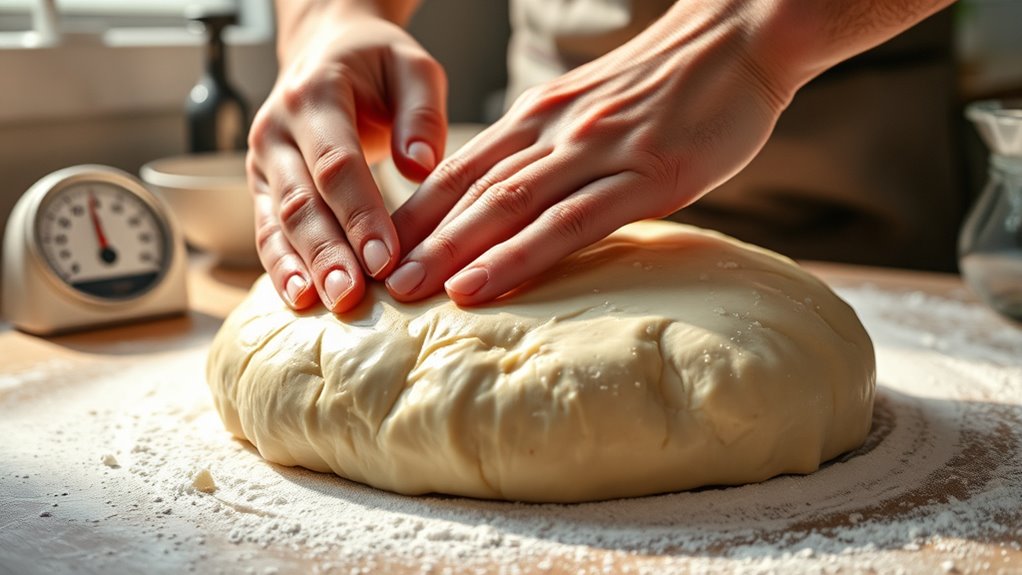
Humidity levels can considerably impact your dough’s consistency and handling, often causing common problems that can be frustrating if you don’t recognize the signs. Too much humidity can make dough sticky and difficult to work with, while low humidity can cause it to dry out and crack. Using humidity sensors helps you monitor moisture levels precisely, so you can adjust your environment accordingly. Climate control devices, like humidifiers or dehumidifiers, allow you to maintain a stable environment, preventing these issues. If your dough becomes overly sticky, increase ventilation or lower humidity. Conversely, if it’s too dry, add moisture or use a humidifier. Consistently regulating humidity ensures your dough behaves predictably, leading to better results every time.
Tips for Baking Perfect Bread and Pastries Regardless of Humidity
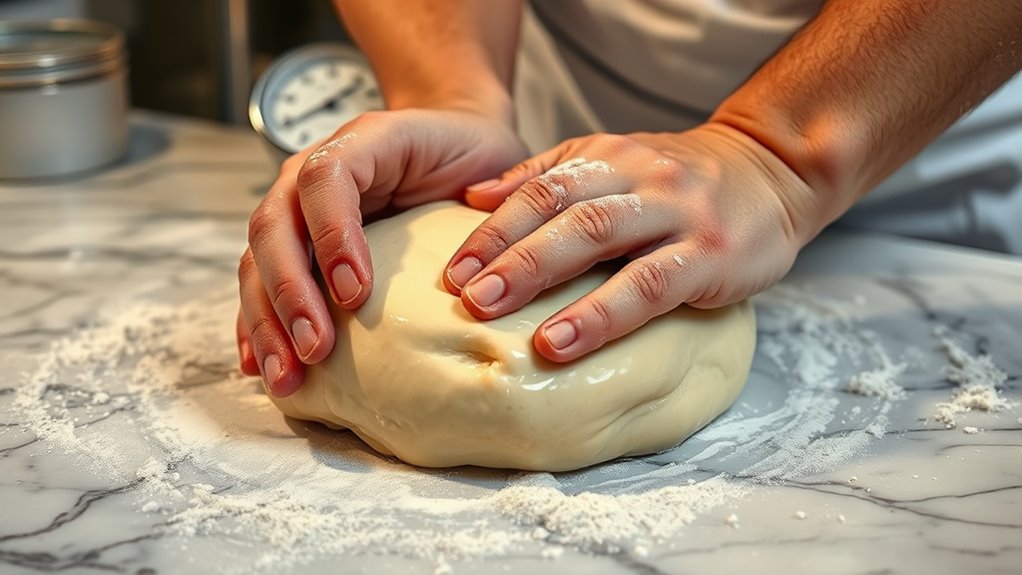
Achieving perfect bread and pastries requires adjusting your techniques to account for varying humidity levels. To compensate, monitor your dough fermentation closely—humid environments speed it up, so you may need to reduce fermentation time. Additionally, controlling oven humidity can prevent crust issues; use steam injections or place a pan of water in the oven for pastries. Here’s a quick guide:
| Humidity Level | Adjustment Tip | Result |
|---|---|---|
| High | Slightly reduce water in recipes | Better dough consistency |
| Low | Increase dough hydration | Softer, more pliable dough |
| Excessive | Limit fermentation time | Prevent over-proofing |
| Low oven humidity | Add steam during baking | Crispy crust, tender crumb |
These tips help you adapt regardless of your environment, ensuring consistent, delicious results.
Frequently Asked Questions
How Can I Measure Indoor Humidity Accurately for Baking?
You can measure indoor humidity accurately with a digital hygrometer, which provides quick and precise readings. To verify its accuracy, calibrate it regularly using calibration methods like placing it in a sealed bag with a salt solution or comparing it with a trusted device. Keep your hygrometer in your baking area to monitor humidity levels, helping you adjust your environment for perfect dough consistency every time.
What Type of Flour Reacts Best to Humidity Changes?
Think of flour as a sponge that reacts to its environment. Bread flour responds best to humidity changes because of its higher protein content, which promotes better gluten development and flour absorption. When humidity rises, it absorbs more moisture, making dough softer and easier to work with. Choosing bread flour helps you manage moisture levels more effectively, ensuring consistent gluten structure and ideal dough consistency regardless of humidity fluctuations.
Can Humidity Levels Affect Yeast Activity During Proofing?
Yes, humidity levels can affect yeast activation during proofing. High humidity helps yeast activate more quickly, leading to better dough elasticity and rise. Conversely, low humidity can slow down yeast activity, resulting in a denser dough that’s harder to work with. To guarantee proper fermentation, keep your proofing environment consistently humid, especially in dry conditions. This way, you promote ideal yeast activity and achieve a light, airy loaf.
Are There Specific Ingredients That Help Regulate Dough Moisture?
Adding ingredients like fat or honey can help regulate dough moisture. For example, a baker might include a moisture-retaining additive such as lecithin to improve consistency in dry environments. Ingredient adjustments like these enhance dough’s moisture retention, making it easier to work with and resulting in better proofing. Incorporate these carefully, as they influence texture and fermentation, ensuring your dough remains supple and well-hydrated throughout the process.
How Do Seasonal Weather Changes Impact My Baking Processes?
Seasonal humidity can greatly impact your baking consistency. During humid seasons, your dough may become too sticky, making it harder to handle, while dry weather can cause it to dry out quickly. To adapt, you might need to adjust your flour or water amounts, or add a bit more flour in high humidity. Being aware of these changes helps you maintain better control over your dough’s texture all year round.
Conclusion
Just like a skilled sailor adjusts their sails to the changing winds, mastering humidity control lets you steer your dough to perfection. By understanding how moisture influences your baking, you can navigate high and low humidity with confidence. With practice, you’ll keep your dough’s temperament in check, transforming each bake into a masterpiece—regardless of weather. Embrace these tips, and soon your baked goods will always rise and shine, like a lighthouse guiding the way.
